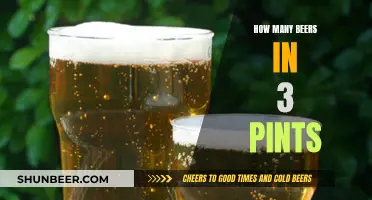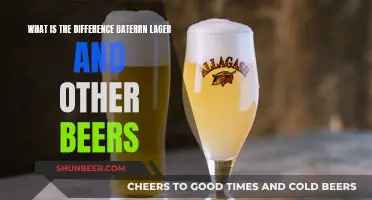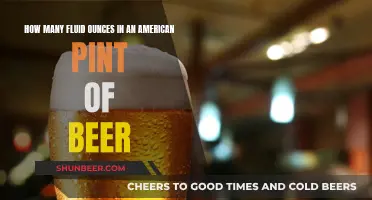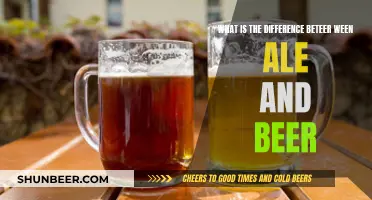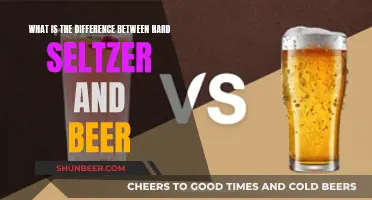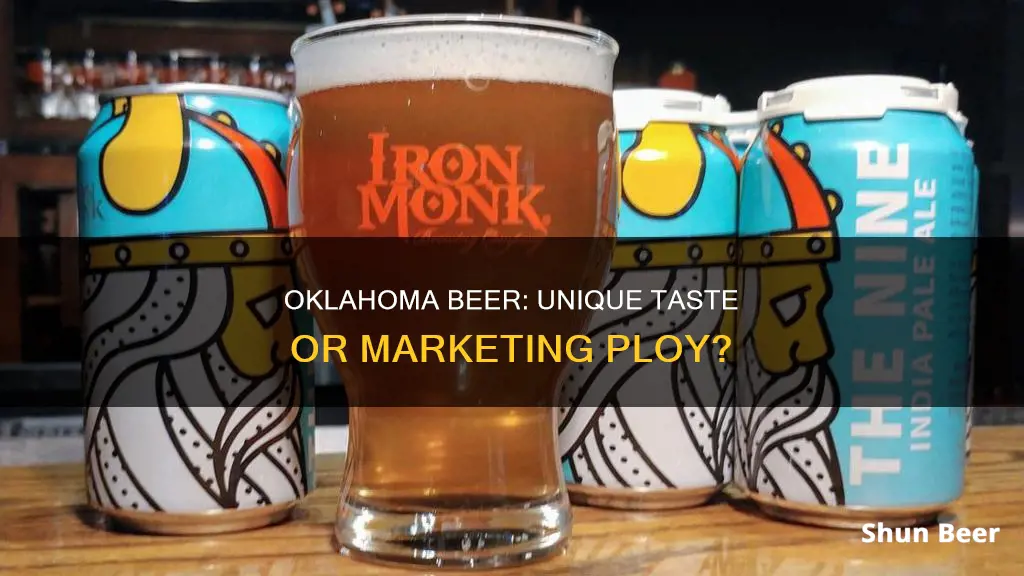
Oklahoma's beer is different from that of other states due to its unique alcohol laws. The state's method of measuring alcohol content, alcohol by weight (ABW), differs from the standard measure, alcohol by volume (ABV). Oklahoma's ABW law means that beers sold in grocery stores and gas stations have a lower alcohol content than those sold in other states. For example, Bud Light in Oklahoma has an alcohol content of 3.2% ABW, which is equivalent to 4.0% ABV, while in other states, it typically has an ABV of 4.2%.
Additionally, Oklahoma's liquor laws restrict the sale of alcohol to specific types of stores and impose certain trading hours. Liquor stores are the only outlets permitted to sell alcohol above 3.2% ABW, and they must remain closed on Sundays and after 9:00 pm. These laws have led to a thriving craft beer scene in the state, with many microbreweries popping up and gaining national and international acclaim.
What You'll Learn

Beer in Oklahoma is measured by weight, not volume
When Oklahoma became a state in 1907, the state constitution included the prohibition of alcohol. In 1933, when the Federal government repealed the 18th Amendment, Oklahoma did not ratify the new 21st Amendment. Instead, it approved the sale of beer containing not more than 3.2% alcohol by weight with the Oklahoma Beer Act of 1933.
In 2016, Oklahoma voters approved State Question 792, which allowed grocery stores, convenience stores, and pharmacies to sell strong beer and wine. This reform also allowed liquor stores to sell cold beverages and non-alcoholic items.
Oklahoma's unique method of measuring alcohol content by weight, rather than volume, has led to some misconceptions about the strength of beer sold in the state. Some residents complain about the "3-point beer" in Oklahoma, wishing they had the "6-point beer" available in other states. However, this comparison is misleading, as the difference in alcohol content between beers sold in Oklahoma and those sold in other states is often negligible.
For example, Bud Light in Oklahoma, which is 3.2% ABW, is equivalent to 4.0% ABV, which is only slightly lower than the 4.2% ABV Bud Light sold in other states. This small difference in alcohol content would require one additional 12 fl. oz. can of Bud Light in Oklahoma to achieve the same level of intoxication as 20 cans consumed in another state.
While Oklahoma's liquor laws may be frustrating for some, particularly those who prefer craft beers or imports, the difference in alcohol content between beers sold in Oklahoma and those sold in other states is often overstated. The perception of weaker beer in Oklahoma is largely due to the state's unique method of measuring alcohol content by weight rather than volume.
Hard Cider vs Beer: What's the Difference?
You may want to see also

Beer in Oklahoma is negligibly less alcoholic than in other states
Beer in Oklahoma is indeed less alcoholic than in other states, but the difference is negligible. Oklahoma beer sold in grocery stores and gas stations is only very slightly less alcoholic than the beer sold in other states. This is because Oklahoma measures alcohol content by weight (ABW), whereas other states measure by volume (ABV).
For example, a beer that is 4.2% ABV in other states will be 3.2% ABW in Oklahoma. However, when converted to ABV, this becomes 4.0%, which is only one-fifth of a percentage point less than the same beer sold in other states. So, if someone in another state drinks twenty 12 fl. oz. cans of a beer that is 4.2% ABV, they will have consumed 10.08 fl. oz. of alcohol. It would take just one extra beer in Oklahoma to consume the same amount of alcohol.
Oklahoma's liquor laws are very different from those in other states. Grocery and convenience stores can only sell "low-point beer" or "near beer", which is beer between 0.5% and 3.2% alcohol by weight. They also cannot sell beer between 2 a.m. and 6 a.m. Liquor stores are subject to different rules and can only sell alcohol between certain hours, and not at all on Sundays or certain public holidays.
Hard Cider vs Beer: Pear Edition
You may want to see also

Beer in Oklahoma can be sold in grocery stores and gas stations
Prior to this reform, grocery and convenience stores could only sell low-point beer or "near beer", which is beer between 0.5% and 3.2% alcohol by weight. This was a result of the Oklahoma Beer Act of 1933, which approved the sale of beer containing no more than 3.2% alcohol by weight.
The reform also allowed liquor stores to sell cold beverages and non-alcoholic items, and implemented a territorial franchise wholesale system, which encouraged major domestic brewers and craft brewers to sell in Oklahoma for the first time in decades.
Despite these changes, there are still some restrictions on the sale of alcohol in Oklahoma. Liquor stores are not open on Sundays, and alcohol sales are prohibited on Thanksgiving and Christmas Day. Additionally, alcohol may not be sold for consumption on-premises or allowed to be consumed in licensed premises between 2:00 a.m. and 7:00 a.m.
Beer Carbonation: CO2 Content Varies by Brew
You may want to see also

Beer in Oklahoma can be sold in liquor stores
Historically, Oklahoma had strict regulations on alcohol sales, with the state constitution prohibiting alcohol when it became a state in 1907. While the 18th Amendment was repealed in 1933, Oklahoma did not ratify the 21st Amendment and instead approved the sale of beer with a maximum of 3.2% alcohol by weight through the Oklahoma Beer Act of 1933. This law was later amended to allow the sale of alcohol stronger than 3.2% ABW exclusively by licensed retail package stores, which could not sell refrigerated beverages.
In 2016, Oklahoma passed State Question 792, a comprehensive reform of its alcoholic beverage laws. This reform allowed grocery stores, convenience stores, and pharmacies to sell strong beer and wine, while also permitting liquor stores to sell cold beverages. However, liquor stores are still subject to operating hour restrictions, and certain sales days are prohibited, such as Thanksgiving and Christmas Day.
It's worth noting that the difference in alcohol content between beers sold in Oklahoma and other states may be smaller than commonly believed. For example, a beer with 4.2% ABV in another state would be equivalent to a beer with 3.2% ABW in Oklahoma, which translates to 4.0% ABV. Therefore, the practical difference in alcohol content is negligible.
In summary, while beer can be sold in liquor stores in Oklahoma, the state's unique measurement of alcohol by weight and historical regulations have contributed to a perception of lower alcohol content in beers sold within the state. However, the actual difference in alcohol content is minimal, and recent reforms have provided more flexibility in beer sales across various establishments.
Crunchy Coatings: Tempura vs Beer Batter
You may want to see also

Beer in Oklahoma can be sold by the drink
In Oklahoma, establishments such as grocery stores, gas stations, and pharmacies with a beer and wine license can sell beer and wine with up to 15% ABV under refrigeration. However, for beer to be sold outside of liquor stores, it must not exceed 3.2% ABW, which translates to approximately 4.0% ABV. This means that popular beers like Bud Light, which is typically 4.2% ABV in other states, will have a slightly lower alcohol content when purchased from a grocery store or gas station in Oklahoma.
Oklahoma's unique alcohol laws have led to some misconceptions about the strength of beer sold in the state. Some people complain that they have to drink more Oklahoma beer to get the same effect as beers in other states. However, this is not entirely accurate. While there may be a slight difference in alcohol content, the discrepancy is negligible for light beers. For example, drinking 20 Bud Lights in Missouri is equivalent to drinking 21 Bud Lights in Oklahoma.
It's worth noting that the difference in alcohol content can be more significant for non-light beers. Additionally, the selection of beers available in Oklahoma may differ from other states due to distribution laws and the refusal of some major brewers to distribute their products in the state.
Oklahoma's alcohol laws have evolved over time, and the state has made strides towards modernisation. In 2016, Oklahoma passed comprehensive reform, allowing grocery stores, convenience stores, and pharmacies to sell stronger beer and wine. This reform also allowed liquor stores to sell chilled beverages and non-alcoholic items. As a result, major domestic brewers and craft brewers have been encouraged to enter the Oklahoma market, providing residents with a wider range of beer options.
Sour Beers: A Unique Fermentation Process
You may want to see also
Frequently asked questions
Beer in Oklahoma is weaker than in some other states, but only negligibly so. Oklahoma measures alcohol content by weight (ABW), whereas other states use volume (ABV). Oklahoma beer sold in grocery stores and gas stations is only very slightly less alcoholic than beer sold in other states.
Oklahoma alcohol laws can be confusing. The state has three alcohol enforcement districts. Alcohol sales are prohibited on Thanksgiving and Christmas Day. Sales are also prohibited between 2:00 a.m. and 6:00 a.m. Liquor stores can only sell alcohol between 10 a.m. and 9 p.m. It is illegal to sell alcohol to anyone under the age of 21, and it is illegal for those under 21 to buy or attempt to buy alcohol. It is also illegal to drink alcohol in public.
Popular beers from Oklahoma include:
- Roughtail Brewing Company
- Black Mesa Brewing Company
- Marshall Brewing Company
- COOP Ale Works
- Anthem Brewing Company
- Prairie Artisan Ales
- American Solera
- Dead Armadillo Craft Brewing
- Iron Monk Brewing Company
- Battered Boar Brewing Company
- Elk Valley Brewing Company
Some breweries in Oklahoma include:
- (405) Brewing Co.
- American Solera
- Angry Scotsman Brewing
- Anthem Brewing Company
- BierKraft
- Battered Boar Brewing Company
- Black Mesa Brewing Company
- Broken Arrow Brewing Company
- Cabin Boys Brewing
- Choc Beer Company
- COOP Ale Works


